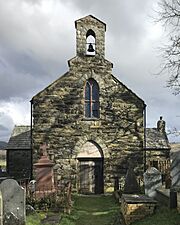St Cynhaearn's Church, Ynyscynhaearn facts for kids
Quick facts for kids St Cynhaearn's Church |
|
|---|---|

St Cynhaearn's Church, Ynyscynhaearn, from the west
|
|
| Lua error in Module:Location_map at line 420: attempt to index field 'wikibase' (a nil value). | |
| OS grid reference | SH 525 387 |
| Location | Near Pentrefelin, Gwynedd |
| Country | Wales |
| Denomination | Church in Wales |
| Website | Friends of Friendless Churches |
| History | |
| Dedication | Saint Cynhaearn |
| Architecture | |
| Functional status | Redundant |
| Heritage designation | Grade II* |
| Designated | 19 October 1971 |
| Architectural type | Church |
| Groundbreaking | 12th century |
| Completed | 1622 |
| Specifications | |
| Materials | Stone with slate roofs |
St Cynhaearn's Church is a very old church in a quiet spot in Wales. It's on what used to be an island in Lake Ystumllyn, not far from Pentrefelin village. This church is special because it's a "Grade II* listed building," which means it's an important historical site. You can reach it by walking along an old path from the village. A group called the Friends of Friendless Churches looks after it now.
Contents
History of St Cynhaearn's Church
This church is named after Cynhaiarn, a saint from the 400s. It was once the main church for the town of Porthmadog.
Building Through the Centuries
The oldest part of the church, the main hall called the nave, was built in the 1100s. Later, in the 1500s, a side wing called the north transept was added. The south transept was built in 1622. Many of the things inside the church, like the furniture, were updated in 1832. They have a style called Georgian. In 2003, the church was taken care of by the Friends of Friendless Churches, and they have been working to repair it ever since.
Architecture and Design
St Cynhaearn's Church is built from stone. The walls of the nave and the east side of the chancel (the area around the altar) are covered in a smooth plaster called stucco. The roofs are made of modern slate tiles.
Church Layout
The church has a short main hall (nave) and two side wings (transepts). It also has a short chancel at the east end. At the west end, there's a small tower for a bell, called a bellcote. You enter the church through a door at the west end. The windows in the nave and transepts have two sections. At the east end, there are three tall, narrow windows called lancet windows.
Inside the Church
The inside walls are covered in plaster above a wooden paneling called a dado. The floor of the main part of the church is made of stone slabs. The floor in the sanctuary (the area around the altar) is painted. There is also a balcony, or gallery, at the west end.
Special Furniture and Features
- Pulpit: The pulpit, where sermons are given, was built in 1832. It's a "three-decker" style, meaning it has three levels. You climb nine steps to reach it. Below the pulpit is a lectern for reading, and below that, a desk for the reader.
- Pews: On each side of the altar, there are box pews, which are like private seating areas. The gallery is held up by thin columns.
- Organ: The church has a chamber organ made in 1834 by Flight and Robson. It was a gift from a Mrs. Walker and cost £30 at the time. It has a Gothic style case.
- Unique Seating: Next to the organ, there are six rows of steeply sloped pews. Many of these pews have the names of the families who used them. One pew even has curtains, which was a special spot for mothers to feed their babies.
- Font: The baptismal font, used for baptisms, stands on an eight-sided pillar made of limestone. It was put in place in 1900.
- Stained Glass: The church also has beautiful stained glass windows made by James Powell and Sons in 1899 and 1906.
Memorials and Famous People
The church has several memorials that tell stories about people from the past.
David Owen, the Harpist
One old grave belongs to David Owen (1712–1741). He was a blind composer and harpist from the area, known as "Dafydd y Garreg Wen" (David of the White Rock). He wrote a famous tune called "Dafydd y Garreg Wen" supposedly on his deathbed, after asking for his harp.
John Ystumllyn, a Unique Story
There is also a memorial for John Ystumllyn (died 1786), also called Jack Black. He was a black man brought from Africa by a member of the Wynne family, who lived at Ystumllyn. Having a black servant was fashionable back then. John was eventually given his own house, had seven children, and lived until the late 1700s. Many local people today believe they are his descendants.
The Spooner Family
Another memorial is for James Spooner (1790–1856), who was a surveyor. He built the famous Ffestiniog Railway. The memorial also remembers members of his family, including his daughter, Louisa Matilda Spooner (1820–1886), who was a novelist. It's a stone urn surrounded by iron railings, located near the church's boundary wall.
Local Tradespeople
You can also find graves for various local people who worked in different jobs, like a baker and a confectioner.

